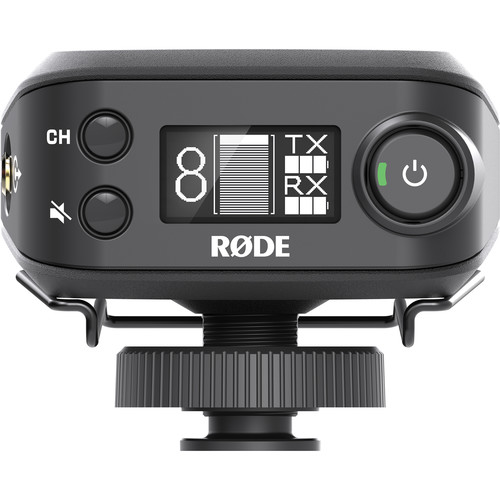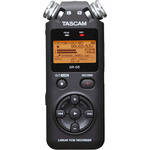Recording with Shotgun Microphones in the Wind
When recording dialogue for my video projects, I prefer to use a shotgun mic when working outdoors. But up until this point, I have not had a proper wind cover for my shotgun mics, just the foam wind covers and furry covers that fit over the foam. And while these help, they don't stop all the wind so I still end up with plenty of distorted bits when the wind makes its way through all of the fur and foam.
B&H Photo was kind enough to loan me a couple of things to evaluate and see whether they would solve this issue. Specifically, they sent over the Rycote Modular Windshield Kit and the K-Tek Avalon KEG 1550 CCR carbon fiber boom pole.
So I put an Azden SGM-250 shotgun microphone into the windshield kit, put it on the boom pole and tested it out in aproximately 15 mph wind for an interview.
And I was pleased to find that it cut all of the distortion that you normally get in the wind when the wind hits the microphone's capsule directly.
The K-Tek boom pole was a pleasure to use with its carbon fiber tubing, internal, coiled cable, and the 90 degree XLR connector near the bottom of the pole (so that you can rest the end of the pole on the ground between takes). The carbon fiber adds a bit to the price but makes for a lighter pole and when you're holding this thing overhead for more than a couple of minutes, every ounce really counts. I plan to buy this one as my first proper microphone boom.
A couple of days later, I met up with my friend Levi Whitney who runs a small production company here in the Salt Lake City area and he happened to have his RODE Blimp wind cover with him. So we had a look over both of them to compare:
It's very similar in design to the Rycote Wind Cover but the first thing I noticed is that it is larger in diameter so it offers a little more space between the diffusion material and the microphone and according to Levi, he hasn't experienced any distortion from wind with it yet. It also comes with the furry cover that RODE calls the Dead Wombat. Cheeky. In any case, I really like them both and they both seem just as effective at eliminating noise. Here's Levis piece demonstrating the RODE Blimp:
So I think I have some pretty good options here in terms of wind covers!
RODE VideoMic Pro with Lyre Suspension and Redesigned Capsule
We had posted this overview of the new RODE VideoMic Pro a few months back but had to pull it because RODE found an issue with the electronics a couple of days after release and recalled it. (Full disclosure: RODE sent me the mike for evaluation. They do not pay me and I retain the right to express my opinion.)
They've got the issue resolved and it is now available online.
Overall, I really like having this in my kit. I'm not a huge fan of using a shotgun mike mounted on top of my camera or rig but there are a few cases where it makes sense. Filming my daughter's marching band in the summer parade this year was one case where it made sense and worked well.
But I also find that this mic works great boomed just above your talent using the RODE VC1 extension cable. In fact, this is how my friend Dave Dugdale shoots 85% of his videos for YouTube (with the older version of the mike). I also like the sound of the new mike. Rich low end when you've got it boomed in close (less than 90cm) . Very neutral when farther away.
If you're wondering whether to get the older version of the mic or spend the extra $40 for the new version, I'd go with the new. You'll have a lot fewer issues with the lyre suspension system in terms of isolating the mike from handling noise and you won't lose and have to repair those pesky rubber bands.
Battery life seems really good as well. I'm still on the original 9v battery and have probably clocked about 8 - 10 hours of use.
RODELink Wireless Lavalier System Review
It's been a lot of work, but here it is, finally: My review of the RODELink Filmmaker Wireless Kit. What do I think overall? This is a good balance of quality for the price (launched at $399 USD).
Pros:
- Digital signal does not drop when working within 50 meters in any of the tests I did, even outdoors and in WiFi heavy offices (because WiFi uses the same frequency in many cases).
- Battery life - lasted 7 hours and 10 minutes on a set of eneloop AA batteries (and this set is about 3.5 years old and has had a lot of use in photo flash units and audio recorders). This is much better than I expected.
- Very simple setup
- Can use up to 8 kits simultaneously
- Good audio quality
- No annoying external antennas
- No latency issues so audio stays perfectly in sync with the video captured by your camera
Cons:
- Plastic body and receiver packs (though it is good quality plastic, it is still plastic)
- Body and receiver packs are a little larger than most others in a similar price range (Perhaps this is the tradeoff for no antennas). Not a problem when mounted on someone's belt behind them but potentially a little more tricky for mounting on brides
One thing that took me a while to figure out is that the mic that comes with the kit sounds a fair bit better when hidden under the shirt of your talent. It seems that it really was made to be hidden vs worn on the outside of clothes. That would explain why they call it a filmmaker kit and not an ENG kit. I just use the RODE Invisilav to make it super simple to mount the mic under the talent's shirt.
Also, it can be used with any mic with a 3.5mm mini stereo jack (TRS) like the RODE VideoMic Pro. So you can even have a wireless shotgun microphone!
RODELink's Lavalier Audio Comparison to Audio Technica AT899
**Status Update 17 June 2015** In further experiments, I've found that the RODE Lavalier sounds a whole lot better when hidden under the talent's shirt. Sounds like this mic was designed for that which is not surprising as this is how they are often used when shooting film (not as much with ENG/News/Doc). Now it makes even more sense that RODE calls this the RODELink Filmmaker Kit. Final review should be out later this week.
I’ve been testing the RODELink to put together a review and a few times paused while post processing and thought to myself, “hmm…this audio seems sort of harsh…” So I did several things to narrow down the issue. I think it is just the nature of the RODE Lavalier mic. Here we have a listen to a clip from the RODE Lavalier and then compare it to a clip from the Audio Technica AT899, a similarly priced lavalier (~$200 USD).
Neither of them are perfect. I would describe the sound of the RODE Lavalier as a little more “forward” or “in-your-face” and the AT899 as smoother in the mid-range but more sibilant. They’ll each complement other’s voices differently than mine. Which do you prefer?
RODELink with Multiple Transmitters?
The question has come up several times now, "Can you transmit from two mics and transmitters to a single receiver with RODELink?"
Short answer: No.
There are wireless systems where you can transmit from multiple body packs to a single receiver, but the receivers are large, usually metal case deals that would not be fit for rigging on a camera and they usually include an AC to DC power brick adapter. These are really designed for live sound and concerts.
The RODELink, just like all the other wireless systems designed for film, video, and ENG are designed to work in the field without AC power and to be small enough to rig on a camera if you're using one or two units.
So, if you're shooting an interview, you will need two kits, each with a transmitter and receiver. But then the question becomes, how do you get the signal from two receivers into your camera that only has one 3.5mm TRS mic input? (often these are referred to as stereo minijack inputs - same thing)
There are probably a lot of other ways, but I use my Tascam DR-60DmkII instead of my camera. But even this only has one 3.5mm input. Not to worry, RODE offers a 3.5mm to XLR adapter for this very purpose! They call it the VXLR adapter and it allows me to plug two RODELink receivers into the two XLR inputs on the DR-60D.
I usually just record the audio with the Tascam and then sync the sound with the video in post. But some people hate doing that and are willing to sacrifice 24 bit audio for 16 bit camera audio. And I get it, there's plenty of debate out there as to whether 24 bit is all that critical. For the record, I always record 24 bit. I'm not saying you have to but here's my reasoning: It uses up very little space relative to high bit-rate video and gives me more latitude to clean things up in post. And for those that argue it doesn't make a difference in post, I'd love to see a specific, compelling example you can show to prove that. Also, syncing in post is really easy. If you're doing a ton of clips, yeah, that's harder and maybe in that case you need Pluraleyes (software from Red Giant that automatically syncs all your audio and video clips from a shoot) to do that for you.
But if you just cannot bother with all that, you could just run the signal out of the Tascam's output to the camera's mic input and then you're all set!
Someone also asked if they could just use a 3.5mm splitter to get the signal from the two receivers into the camera. In theory that should be possible. Of course you're back to using the camera's preamp (which is pretty poor quality with most cameras that have 3.5mm inputs) and 16 bit audio for most cameras. So, your results may be less than optimal.
If this is your first exposure to the RODELink wireless mic system, we've done a couple of video episodes on it so far that you might find interesting:
RODELink Distance and Interference Tests
One of my biggest concerns when I first heard about the RODELink wireless lavalier system was how well they would hold up in environments with a lot of potential interference, like corporate offices with lots of wifi network activity. Also, I was curious to learn how well it would perform when you use two kits simultaneously. So in this episode we put the RODELink to the test in two scenarios: First, we have our actors walk around a corporate office away from the receiver unit until we experienced the signal dropping. We also recorded a mock interview with two kits in a wifi heavy office building. Let’s see how RODELink held up!
(Pretty well, it turns out)
New RODE VideoMic Pro 2015: Overview and Demo
I will start by saying that I am not a fan of on-camera mics, even things like cold-shoe mount shotgun mics. There are two problems with using shotgun mics on the camera: 1) The camera is almost never close enough to the talent for a short shotgun mic to get a good dialogue recording without picking up lots of ambience. If that's the sound you want, then this is fine, but usually we're looking to eliminate most of the ambient sound and noise. 2) the mic is pointed not only at the talent, but at all the other sound and noise behind the talent or reflecting off the wall behind the talent. That's not quite as big a deal, but still a problem if you're trying to get just the dialogue.
However, cold-shoe mount mics can be used closer to your talent. And the newly redesigned (2015) RODE VideoMic Pro with Rycote Lyre shockmount is a fine candidate for this. In this episode I demonstrate the difference between using it on camera and using it boomed within 40 - 60cm of your talent.
But of course, you have to find a way to get the mic connected to your camera if you're operating 6 feet away from it. And my favorite options are these:
RODE VC1 (10 foot extension cable). This is the least expensive option and simply allows you to run the cable from just over your talent to your camera. Works great if you're still within about 6 feet of your talent. Runs for around $10 USD.
Zoom H1 or Tascam DR-05 Audio Field Recorders. I have the H1 but if I were buying today, I'd go for the Tascam because of its slightly better build quality. These allow you to connect the mic directly to the audio recorder. These are so light weight that you can just put them up on a stationary boom in studio, or combine it with the VC1 extension cable. The advantage with this approach is that these recorders will almost certainly record higher quality sound than 99% of cameras. On the downside, if you really want to look at it that way, you will have to sync the sound to the video when you edit in Premiere, Final Cut, or which ever editing app you use. It is super simple and worth the 10 seconds of extra work from my point of view.
Then, of course, there's the issue of how to boom the mic. This is a little more complicated but here's a reasonably affordable way to boom the VideoMic Pro if your talent will be sitting in one place.
Just another option to consider for capturing quality sound for your film and video projects.
Re-designed RODE Video Mic Pro
In 2010, RODE introduced their Original Video VideoMic Pro, a cold shoe mount small shotgun microphone. According to today's press release, this is their best selling microphone. That's interesting, I would have expected the NT1A large diaphragm condenser to be their best seller among the beginning home music recording crowd.
One problem with the original Video Mic Pro was the isolation mounting. It essentially used rubber bands that worked decently, but had a tendency to fall off or break over time. And, they weren't the best at isolating the mic from camera or boom movement.
Earlier today, RODE announced an updated version of the VideoMic Pro with Rycote Lyre with two new headline features: a redesigned capsule, and a new Rycote suspension system.
Now those of you that know me, know that I'm not a huge fan of mounting a shotgun mic on top of my camera. That technique has its place, but I rarely do it because it doesn't sound all that great for two reasons: 1) it is usually too far from the talent and 2) it also picks up whatever happens to be behind the talent (and that can include audio reflections off a wall if that's what is behind the talent).
However, like I said, there are cases when you don't have any other choice. When I met up with Dave Dugdale at NAB this year, I saw that he was shooting with his Video Mic Pro on his Sony A7s. Totally get it. He didn't have a lot of other options since he was trying to stay light for a full day of walking around the show floor and the audio quality expected from this setup was good enough for what he was doing. Totally legitimate.
However, in cases where you're shooting at a location where it would be practical, I like to take that mic off the camera and boom it over the talent. This solves both problems: The mic is now much closer (within 40 - 60cm of the talent) and it is pointed down so it only captures the talent and not everything behind them. I showed this in one of my older episodes and will do it again in one of my upcoming episodes.
In that light, RODE was kind enough to send me an evaluation copy of the new Video Mic Pro a while back so that I could evaluation it. Frankly, I've only spent a few minutes with it so far because I've been busy working with the RODELink system, but I'm hoping to have a closer look at it in the next few weeks here.
The new mic is just a tiny bit larger than the original and the foam windscreen is larger so the original dead cat furry cover won't work with the new mic. But I would hazard a guess that RODE will have a new version of the dead cat available before too long.
Let me know if there are any specific questions you'd like answered about this mic and we'll be sure to cover that in the episode.
RODELink Wireless Audio: Initial Test & Overview
https://youtu.be/o6P59ZxpANI You voted that you wanted a review of the RØDELink wireless audio system a few months back and here is the initial test as I put together the full review over the next few weeks. So far, this system looks like a nice fit for enthusiasts and pros working with small crews. One thing that really impressed me was that the Filmmaker kit comes with the RØDE Lavalier microphone which on its own is normally a $250 US microphone which is more than half the price of the filmmaker kit. In my initial tests I have not experienced a single drop out though admittedly, I haven’t yet stress tested it by taking two units into a heavy wifi environment (that’ll come in the full review). So I hope this whets your appetite while I work on the full review.
My initial impression is that the RODELink Filmmakers Kit hits a very nice combination of price to build and audio quality. We're planning some stress tests (throw a bunch of wifi at it and record with two transmitters and receivers in an interview, distance) and should have the full review up in another couple of weeks. Let me know if you have any questions you would like answered specifically!
RØDE NTG4+ Shotgun Microphone Review
https://youtu.be/B8aE0loboMA It's here and everything I had hoped it would be! But is it for everyone?
A couple of months ago you all voted on what you wanted to cover next and one of the things you voted for was a review of the RØDE NTG4+ shotgun microphone. This is RØDE’s next generation enthusiast/pro shotgun mic and it has a few interesting features:
- The "+" version has an inbuilt lithium battery that can power the mic for 150 hours - A re-designed microphone capsule (which I think sounds a bit more natural than the NTG2 with less of the low frequency boost that sounds like FM radio announcers) - Electronic buttons for high pass, high frequency boost, and -10 dB pad as well as mic power
We’ve spent a few weeks working with it and it is a great, very versatile mic! RØDE has done a great job filling a hole in the shotgun mic market. Better quality than the $100 - $300 mics and added features that make this mic incredibly versatile.









 Support Me on Ko-fi
Support Me on Ko-fi
